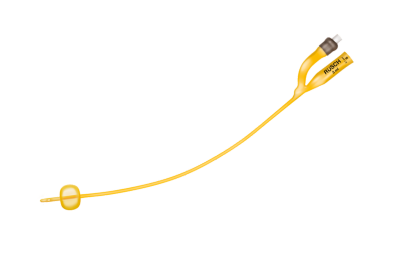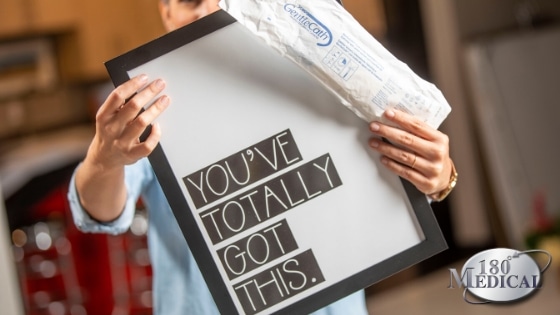
Adjusting to a big life change isn’t always easy. After your doctor says you need to start using catheters, the idea can feel overwhelming or even scary. However, the good news is that most people find using a catheter quite easy with some time and practice. Get started on the right path with 180 Medical’s helpful tips and support!
Tips for Easing the Transition to Using a Catheter
Here are a few quick tips when you’re new to cathing.
Tip 1. Make Sure You’re Using the Right Catheter Type
First, talk with your doctor about what catheter product type they think is best for you. However, it’s a good idea to approach these topics well-informed of your options.
Here are the 3 different types of urinary catheters:
1. Intermittent Catheters
If you’re physically able to self-catheterize or you have a caregiver who can help you cath, doctors may prefer to prescribe intermittent catheters. With intermittent catheters, you insert a sterile catheter tube a prescribed number of times per day to keep your bladder regularly emptied. This helps exercise the muscles of the bladder, allowing it to fill and empty at scheduled intervals, which mimics the way a functioning bladder works.
Plus, intermittent catheters don’t require the use of a drain bag or leg bag like other catheter options (listed below), which gives individuals much more independence, range of motion, privacy, and confidence. Instead, simply direct the flow from the end of the catheter toward a receptacle like a urinal or a toilet. Also, certain types of intermittent catheters have urine collection bags that you can drain into and then dispose of discreetly.

Intermittent catheters come in a variety of options, including straight and coudé tip; female, male, and pediatric lengths; pre-lubricated and hydrophilic catheters; uncoated catheters; closed system catheters; and catheter kits.
2. External Catheters
Males with urinary incontinence often use external catheters. Typically, external catheters fit over the penis almost like a condom. From there, urine drains into an attached tube, which leads to an external urine collection device like a leg bag or a drain bag.
3. Foley Catheters
Foley catheters, also known as indwelling catheters, remain inside the bladder to keep it fully drained. Doctors or medical staff will typically handle inserting the Foley catheter for you. Then urine will drain into a collection device throughout the day.
To collect urine from both external catheters and Foley catheters, people typically use drain bags that hook onto their bed or wheelchair, or they may use leg bags, which attach to the leg. One downside of this method is that you must regularly empty, clean, and/or replace the urine collection bags to avoid back-ups, leakage, and unpleasant smells.
Additionally, Foley catheters remain inside the body for long periods of time. Therefore, users may have an elevated risk of urinary tract infections (UTIs) and bladder infections.

No single type of catheter works for everyone. Above all, talk to your doctor and listen to their recommendations.
Tip 2. Learn How to Properly Use Catheters
Typically, you’ll first learn about using a catheter from your doctor or nurse in a clinic or hospital setting. Pay close attention to the way they instruct you on how to utilize a catheter properly. They should also offer some information on how to practice proper catheterization hygiene to help you avoid infection or complications.
180 Medical gladly offers educational material to our customers, such as DVDs and booklets with step-by-step instructions and hygiene tips. In addition, we also offer a helpful How to Catheterize page for beginners. You can find instructions there on how to use any type of intermittent catheter for men, women, and children.
Tip 3. Use Adequate Lubrication to Minimize Discomfort
First-time catheter users sometimes encounter painful or uncomfortable catheterization. One of the top ways to make cathing less painful is by making sure to use plenty of good-quality lubricating jelly with your uncoated catheter.
Advanced products like hydrophilic intermittent catheters or closed system catheters may feel even more comfortable. This is because they are often either pre-lubricated or have a coating that, once activated by water, becomes slippery smooth. This may help reduce friction inside the urethra.
Tip 4. Reframe Your Outlook
Lastly, when it comes to a change that may seem unpleasant at first, consider shifting to a more positive perspective. Optimism and affirmative self-talk can often make all the difference in adjusting to life using a catheter.
One way to do this is to remember that catheters help you stay healthy. Next, take a look at some of our featured inspiring stories of real people who have been through big life changes and challenges, many of whom use catheters, incontinence supplies, or other medical equipment every day. So many of these amazing people may have reasons to give up or view their circumstances negatively. However, they focus on staying positive and maintaining their quality of life.
You have that opportunity now as someone new to using catheters.

Tip 5. Choose a Reputable Supplier for Your Catheter Needs
Adjusting to using a catheter may feel difficult at first, but when you choose 180 Medical as your catheter supplies provider, you have our entire team supporting you.
We make every step of ordering catheters as easy, convenient, and hassle-free as possible. Our friendly specialists will gladly help you out with any questions or issues you may have with your current catheter product. We’ll quickly verify your insurance plan to determine your coverage. Also, we can send free samples of different types of intermittent catheters to try out.
We want you fully satisfied with your catheter supplies, and we’ll do all we can to help make the transition to using a catheter smooth and seamless for you.